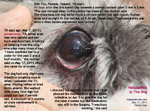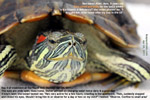2 old dogs can't stand on
their hind legs
Dr Sing Kong Yuen, BVMS (Glasgow), MRCVS
Date:
18 May, 2011 |
 toapayohvets.com toapayohvets.com
Be Kind To Pets
Veterinary Education
Project 2010-0129 |
Case 1. The Shih Tzu has back ache
"I was told to come at 9 am if I want to consult you," the
lady with a Shih Tzu was waiting on this fine Vesak Day. I do
morning consultations and surgeries daily except Saturdays and
usually I require appointments to be made.
It was 70 days ago and I was surprised to see the owner's
mother. The owner was actually the daughter who is studying
overseas and was diligently ensuring that her mother take good
care of this old Shih Tzu. I guess the daughter grew up with
this dog and loved her very much.
I took out the case card and there was a note saying that I
had phoned the owner's mother to come to collect the
medication for the dog with back ache problems. The dog was
hunched and could not stand on her hind legs 70 days ago. I
had given medication and injection and advised strict cage
confinement for at least 3 months. Also, a follow up one month
after the injury to the back.
 "Why
didn't you come to pick up the medicine to bring down
inflammation for the dog for another 4 weeks?" I asked as Mr
Min took out the bag of medicine from the cabinet. I checked
the T/L spinal area by pressure using my forefinger and middle
finger to press directly and firmly from the neck to the tail.
At the spinal area around vertebra T10 to L3, the dog reacted
with a soft "ha" and did so when I repeated the palpation. It
was a quiet "cough" but the mother confirmed she could hear
it. There was no painful whimpering on spinal palpation now.
When I placed the dog's hind legs onto the edge of the table,
the dog could not put her hind feet forward instantly. I
showed the owner that the dog could do so with the front feet.
So, the placing reflex was still absent in this dog and she
has not fully recovered. "Why
didn't you come to pick up the medicine to bring down
inflammation for the dog for another 4 weeks?" I asked as Mr
Min took out the bag of medicine from the cabinet. I checked
the T/L spinal area by pressure using my forefinger and middle
finger to press directly and firmly from the neck to the tail.
At the spinal area around vertebra T10 to L3, the dog reacted
with a soft "ha" and did so when I repeated the palpation. It
was a quiet "cough" but the mother confirmed she could hear
it. There was no painful whimpering on spinal palpation now.
When I placed the dog's hind legs onto the edge of the table,
the dog could not put her hind feet forward instantly. I
showed the owner that the dog could do so with the front feet.
So, the placing reflex was still absent in this dog and she
has not fully recovered.
"I have put the dog inside the cage for the last 2 and a half
months," the mother said. "She would like to run all over the
apartment like a bullet train but I did not allow her to do
so."
"The news is good," I said. "Strict cage confinement for the
last 2 and a half months helps the injured disc area to heal."
I did not dwell more on her missing out on the NSAID
medication as she had already said she was busy working. I
decide that I must implement a system of putting such reminder
info on a notice board so as to give a second reminder in the
interest of the dog.
"I have been busy working," the mum said. "What are the two
lumps on the dog's back?"
"The two cauliflower lumps are warts," I said. "Older dogs do
get warts and the cause is said to be a virus."
"What is your advice?" the mother asked me whether a 3rd small
swelling nearer to the tail was the 3rd wart.
"I will advise clipping of the coat and see how many warts
there are. Get all warts excised when they are small. Nobody
knows exactly why warts appear. Warts appear in very young and
old dogs. I had a case where the dog had over 50 warts because
the vet advised that there was no need to do anything. The
warts got infected and bleed and so I had removed all of them.
Some do return but most had gone in this old dog."
Spinal disc injury cases need monthly follow-up by the owner
for the first 3 months. Unfortunately many don't if they see
the dog as improving.
There is a grey line crossed if vets phone up the owner to get
the follow up done as the owner may ignore or mis-construe
that the vet is soliciting for business.
CASE 2. The Miniature Schnauzer can stand up only when
given steroids.
Recently, my specialist in the Singapore General Hospital
phoned me about his friend's dog, a 9-year-old Miniature
Schnauzer who could stand up and walk if he takes the
steroidal drugs. Without the drug, the Schnauzer could not
stand up.
The doctor said: "The Schnauzer could have 'mini-strokes'
earlier as his head tilted to one side. Vet 1 gave the
steroids and the dog improved. Then he could not get up to
walk on his hind legs and Vet 1 gave steroids. The dog could
walk only when he takes the drugs. What is your diagnosis?"
 "Didn't
Vet 1 provide the diagnosis?" I asked. "Didn't
Vet 1 provide the diagnosis?" I asked.
"She said there was nothing wrong with the dog," the
specialist said.
I found this hard to believe and advised him to get the
medical records as Vet 1 is an experienced battle-hardened
vet. The dog owner was very distressed and so the specialist
phoned me for a short consultation out of the blue.
"Is there any cure if the dog has spinal disc injury?" he
asked.
"There is the surgical treatment," I said. "But in most cases,
there is no permanent cure and the surgical treatment needs to
be expertly done by an experienced vet."
I advised tapering off the steroid and stopping all steroids
if the specialist's friend wanted me to examine the dog.
Pain-killers mask pain and therefore there was no point in
being consulted as I would not be able to locate the injured
spinal area by palpation. X-rays may help. In any case, a
telephone diagnosis is very risky and unprofessional and I
tried not to give any diagnosis as things don't appear to be
what they are on the ground as compared to telephone
imaginations and conversations.
P.S. Dogs with head tilted to the side would appear to suffer
from "mini-strokes" to the human medicine doctors as they
equate hemi-paralysis of the face and body with strokes or
mini-strokes. In dogs, the most common cause would be otitis
media! |
|
Advertisement |
|
|
|
 More
info at:
Dogs or
Cats More
info at:
Dogs or
Cats
To make an appointment:
e-mail
judy@toapayohvets.com
tel: +65 6254-3326 or 9668-6469 |
 toapayohvets.com toapayohvets.com
Be Kind To Pets
Veterinary Education
Project 2010-0129 |
|
|
 TOA
PAYOH VETS
TOA
PAYOH VETS TOA
PAYOH VETS
TOA
PAYOH VETS